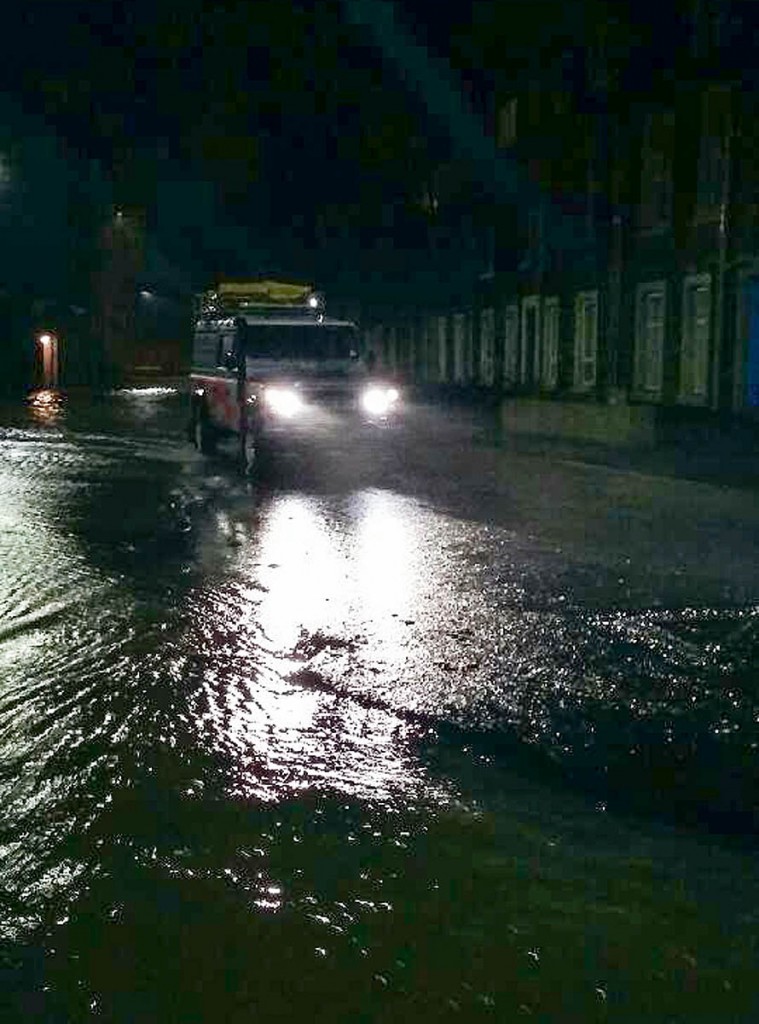A mountain rescue team has given an insight into two days’ events when nature threatened residents of southern Scotland and north-west England.
Tweed Valley Mountain Rescue Team was one of many volunteer teams who responded when Storm Desmond caused some of the worst floods in years, leading to thousands of people being evacuated from their homes.
The team released a diary covering 45 hours as the severe weather approached and then hit Cumbria, Northumberland and the Scottish Borders, flooding many towns and villages and washing away bridges and roads.
David Wright, Tweed Valley MRT spokesman said: “During the above period a major incident plan was put into place across the Scottish Borders to deal with adverse weather and flooding in the Scottish Borders.
“Tweed Valley Mountain Rescue Team played a role in responding to this incident. There were many agencies and organisations involved, each playing their own vital role but this statement is written to give a summary of the work which was carried out by TVMRT.”
Friday 4 December
- 3pm: Police Scotland contacted TVMRT to advise that severe weather was forecast with high risk of flooding in certain areas of the Scottish Borders. Police Scotland requested TVMRT to consider themselves on ‘standby’ to react to any issues that may materialise due to the weather and to advise what equipment and MRT personnel would be available to assist over the weekend.
At this stage, 28 TVMRT members declared availability at varying points over the weekend, along with the team’s two Land Rover ambulances and incident control vehicle.
Saturday 5 December
- It was 45 minutes past midnight when Police Scotland contacted the team for assistance in implementing an evacuation plan of certain areas of Hawick due to the potential of the River Teviot bursting its banks.
TVMRT was able to respond with 14 team members and three vehicles; team leader Peter Matthews took a seat in the incident management centre at the Scottish Borders Council HQ in Melrose. Incident manager Bill Glennie was based at Hawick police station to work with the local police management team and the other 12 team members were deployed into areas of Hawick.
The tasking for team members initially was to pair up with police officers and advise residents that there was a high risk that their property may need to be evacuated. Residents, at this stage, were advised to move their vehicles to higher ground given the high probability that their streets could become flooded.
- At about 4am, the decision was made by the authorities to begin to evacuate properties in areas deemed high risk and TVMRT members assisted the police in this evacuation.
The evacuation continued into daylight hours with TVMRT being stood down at 8am and handing over to the Border Search and Rescue Unit and Borders Water Rescue Team.
- At 12.45, Tweed Valley MRT incident managers led the Scottish Mountain Rescue response to an assistance request from Lake District Search and Mountain Rescue Association regarding significant flooding in the Carlisle area.
Arrochar, Moffat and Galloway teams responded with availability and although it was later confirmed that adequate resource was available in the Cumbria area, these teams were requested to remain on standby to assist with the ongoing incident in the Scottish Borders.
- At 3.30pm the team was again requested to attend Hawick, to relieve the Border Search and Rescue Unit and Borders Water Rescue Team. At the same time, Police Scotland asked if TVMRT also had capacity to deploy to Newcastleton. This area was now flagged as high risk for flooding with evacuations needing to be carried out. As TVMRT was fully committed with 20 MRT personnel to Hawick, the Moffat Mountain Rescue Team was called in to assist providing 17 MRT members and two 4×4 vehicles.
While Moffat MRT was carrying out evacuation work in Newcastleton, TVMRT was deployed into various areas of Hawick in the team’s 4×4 vehicles with the aim of ensuring residents who had chosen to remain in their houses were safe and that members of the public who taking the opportunity to look at the floods were aware of which areas were safe and where to avoid.
For the mountain rescue teams, work continued into the evening with Moffat team standing down at midnight and the MRT work in Hawick concluding at around midnight.
Sunday 6 December
Although the TVMRT members in Hawick stood down at midnight, concern was growing for the River Tweed in Peebles. Five TVMRT members who had been released from duties in Hawick and lived in the Peebles area were deployed to Peebles to work with the police to assess the situation on the ground. Flood defences were holding well and water was about 12 inches below the flood gates in the Tweed Green area.
Despite the early hour, many members of the local community were awake and were keen to talk to team members about the situation in the Borders and also about the potential for high impact flooding in the Peebles area. Team members and police officers were able to give reassurances advising that river levels were being monitored and contingency plans were ready to be put in place if the risk of flooding increased.
TVMRT remained on point in Peebles until confirmation was received that both SEPA and the Met Office had concluded that river levels were stable and were due to recede. At 3.30am TVMRT stood down for the evening.
- At noon on Sunday 6 December, Police Scotland advised that it was unlikely that further MRT assistance would be required in the TVMRT operational area and the team was formally stood down from the overall incident.
